Art, Ideology and Power: Political Appropriations of Art Museums in Asian post-colonial contexts
Patrícia de Sousa MeloThe Macau Museum of Art as a case study
1. Introduction
Globalization and expansion and development of the information and communication technologies, in the last decades of the 20th century, urged museums to rethink their identity and to reconsider their strategies and institutional practices, in order to sustain its relevancy in the contemporary society (Hooper-Greenhill, [1992] 2004; 1995; McLean, 2003).
The Modern Museum, which aimed to discipline and civilize through the curatorial authority, sustained by a transmission model of communication, where the audience was not considered nor included in that process, gradually gave way to the Post-Modern Museum (Bennet, 1995; Hooper-Greenhill, [1992] 2004; 1995; 2000). Its reflexive attitude prompted a shift of the communicative paradigm of these institutions – a holistic communicative approach (Hooper-Greenhill, [1992] 2004; 1995) where visitors are regarded as a pro-active element, thus becoming more inclusive and open to the public and especially to local communities (Hooper-Greenhill, [1992] 2004; 1995).
However, even though museums, as institutions with European roots, were transplanted and created across the globe, these reflexive practices aren’t universal. One can ascertain, in some non-Western cultural and geographical contexts, the persistence of the values and attributes of the Modern Museum – symbol of status and prestige, an instrument of the dominant political power, expressing state ideology through its collections and displays.
This is the case of People´s Republic of China (PRC), a country ruled by The Communist Party of China (CPC), – where schools and museums are a part of the Patriotic Education, conveying nationalist messages that aim to establish cultural hegemony and an identification with the Chinese national identity[1].
During the fieldwork conduct in Macau for my PhD dissertation[2], I noticed that the same situation, although in a smaller scale, appeared to occur in the Macau Museum of Art (MAM), despite the fact that Macau Special Administrative Region (SAR) is an autonomous territory and, consequently, economically, politically and socially distinct from mainland China.
Hence, this paper will explore[3] the institution’s political appropriation by the Central Government for ideological purposes, and the fact that in some ways it still holds some of the attributes of the Modern Museum, which don’t reflect and contemplate the new institutional practices of museums in the 21st century. I will analyse MAM’s space, mission, functional aspects and its discourses about collections and exhibits. Nonetheless, this examination cannot be separated from the political, economic and social context of the territory, from its early formation period in the 16th century to its current configuration. This essay is thus divided in two parts: a brief characterization of Macau’s SAR history, and the presentation and examination of the mentioned museum’s elements.
2. The Macau Museum of Art (MAM)
2.1. Macau’s Historical context
Macau is located in the Pearl River Delta; it borders the Chinese province of Guangdong and lies about 64 km from Hong Kong. The city developed from the Portuguese settlement in the 16th century. Its political status was dubious and ambivalent and was founded on the official consent and authorization, from the Chinese Emperor, for the Portuguese to settle down and administer the territory, even though it would remain in China's possession (Ping & Zhiliang, 2007). The anomalous colonial situation of Macau, very different from other Portuguese and European colonies (Cheng, 1999; Santos, 2002), and the singularity of the political situation, soon stimulated a dynamic trade and the expansion of the commercial sector, which was responsible for the increase of population, especially of Asian and Chinese groups (due to geographic proximity).
The economic prosperity of the city in the 16th and 17th centuries and the harmony and pacific coexistence between the multicultural communities (particularly between the Portuguese and the Chinese), was only shaken in the 19th century, a period when all the European colonialist states strived to keep their overseas Empires. Following this tendency, Portugal decided to reinforce its power in and over Macau (Cheng, 1999; Ping & Zhiliang, 2007)[4], a situation that prompted some major conflicts between the two latter communities and that spread across the 20th century[5].
Even though Portugal tried for several times, especially after 1974, to «return» the territory to China (Fernandes, 1996; 2003), only in the 1980s the two parts settled on an agreement[6]. Consequently, there occurred no decolonization process, similar to what happened in other European and Portuguese colonies, but a «Handover Ceremony», when the administration of the territory was passed down to the Chinese government, on December 21th, 1999. During the transition era[7], the Portuguese government conducted numerous reforms in the various sectors of Macau life, such as the cultural one. Measures for protection of cultural heritage were implemented and many museums were created (Cheng, 1999; Clayton, 2003). Despite the fact that these interventions were urgent and much needed[8], they represented a way for Portugal to leave a mark and a historical legacy on the territory, after four centuries of historical and cultural permanence (Cheng, 1999; Clayton, 2003). It was in the context of the restructuring of the cultural sector, that the Macau Museum of Art (MAM) was created, on March 19th, 1999.
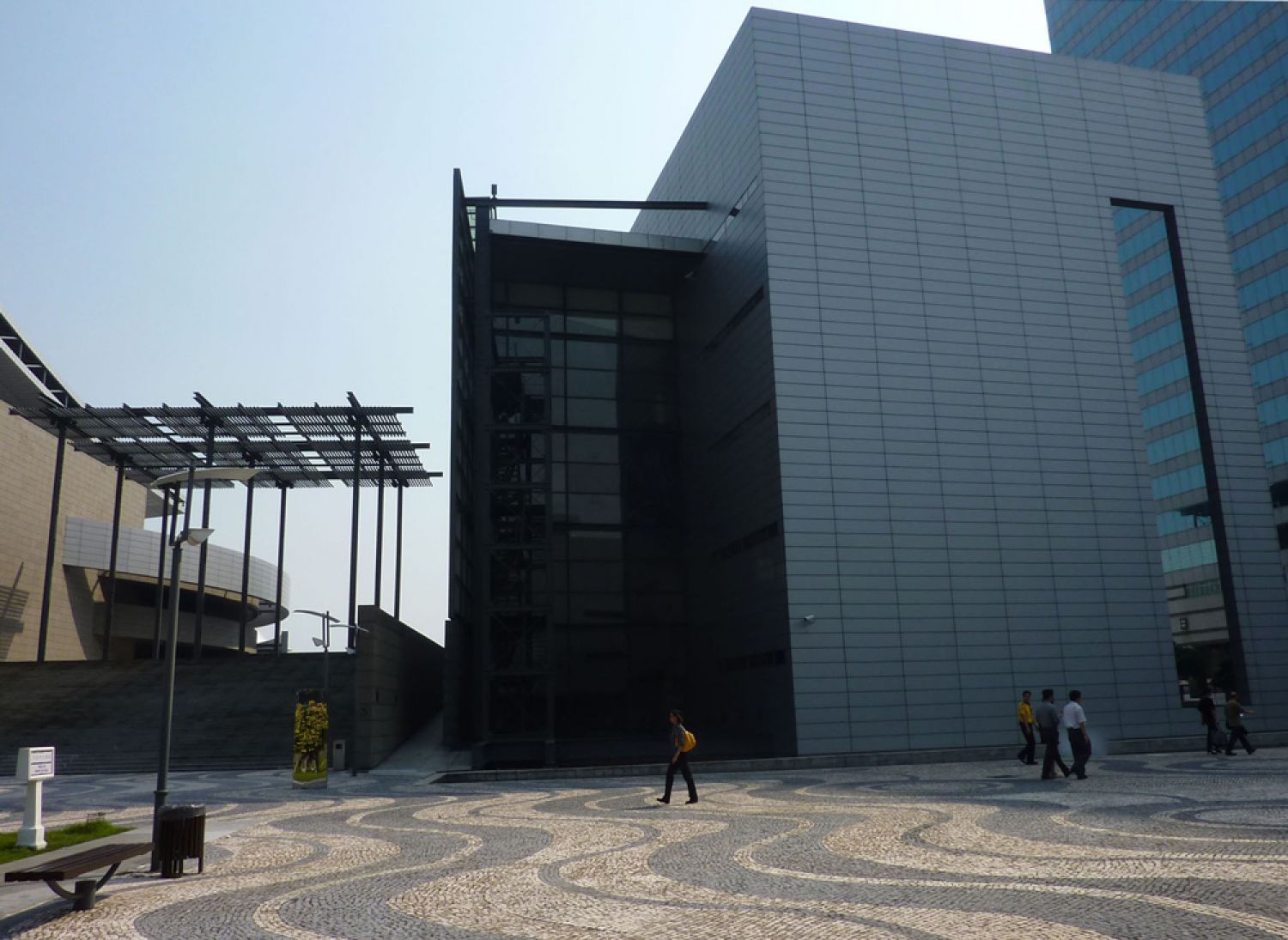
2.2. Analysis of the Macau Museum of Art
1. Location and building characteristics:
The Macau Museum of Art, the Cultural Centre of Macao, the Macao Science Centre and the Handover Gifts Museum (HGM) form a cultural complex of contemporary architecture, implemented in one the newest areas of Macau (NAPE)[9]. This specific location was chosen not only because it was recent and consequently had plenty of space for construction[10], but also because it neighboured the HGM, built precisely where the Handover Ceremony was held, establishing a strong connection between the two institutions, which will be examined further down.
Thus the inauguration of this architectural icon, on the eve of an important historical and political event, symbolically marks the end of an Era and the beginning of another one. Moreover, it contributes to the valorisation of part of the city, obtained by land reclamation, and it creates a cultural landmark on the urban landscape of Macau, generating new social and cultural dynamics.
2. Museum spaces and facilities
The Macau Museum of Art, which belongs to the Cultural Affairs Bureau of Macau SAR[11], is «the largest and only museum fully dedicated to the arts in Macau»[12]. It has 10,192 square metres, distributed by five floors and ten exhibition galleries.
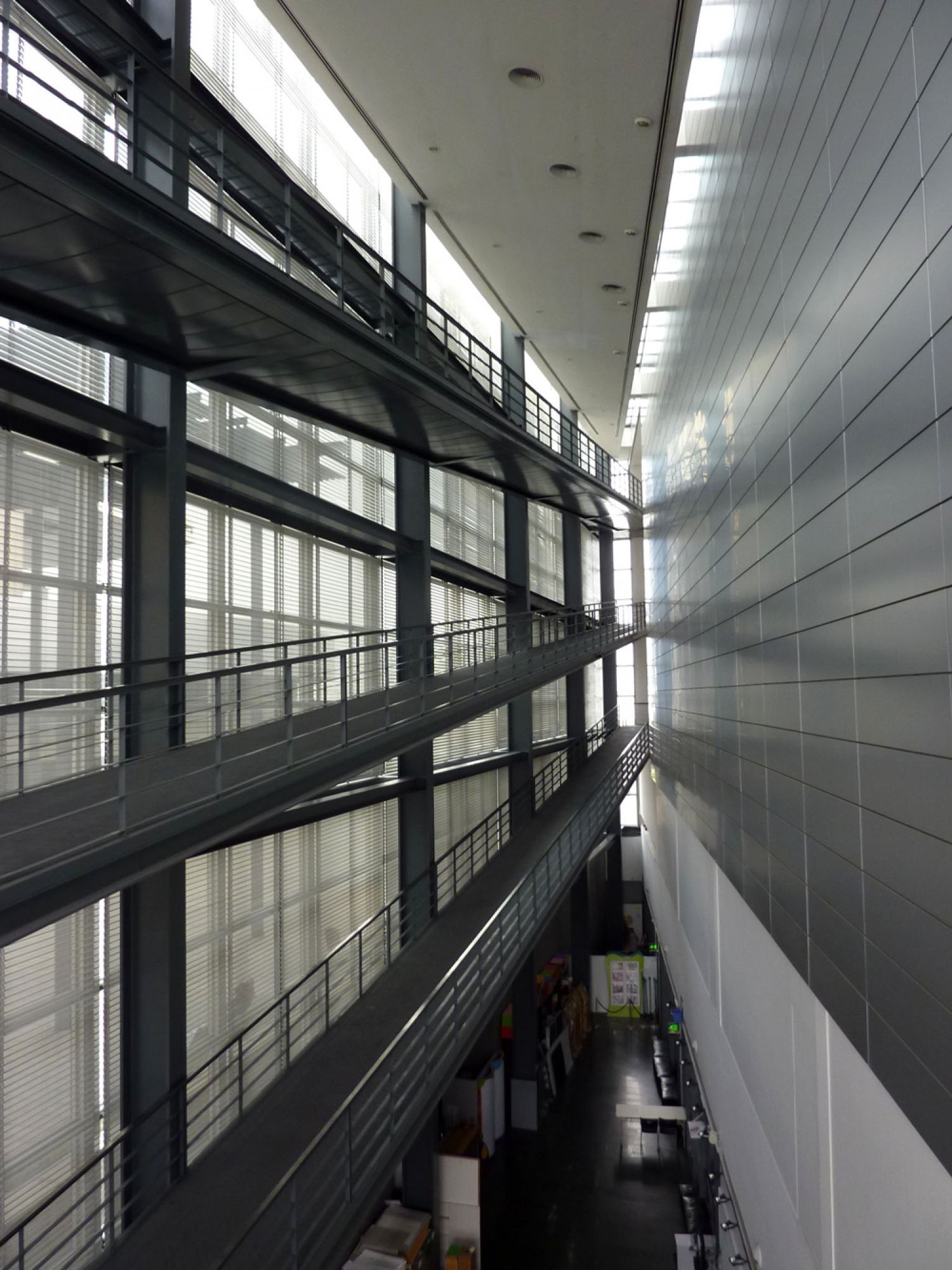
The entrance, visitor reception, stores and museum facilities are situated in the ground floor. The museum also comprises an art library, an auditory for special events, and educational services that organize exhibition-related public programmes and workshops.
The museum houses two shops: The MAM shop, selling merchandise, books and other materials related with the museum’s collections and the Museum of Imperial Palace Shop, displaying a range of gifts related with the collections of the Imperial Palace in Beijing (the Forbidden City).
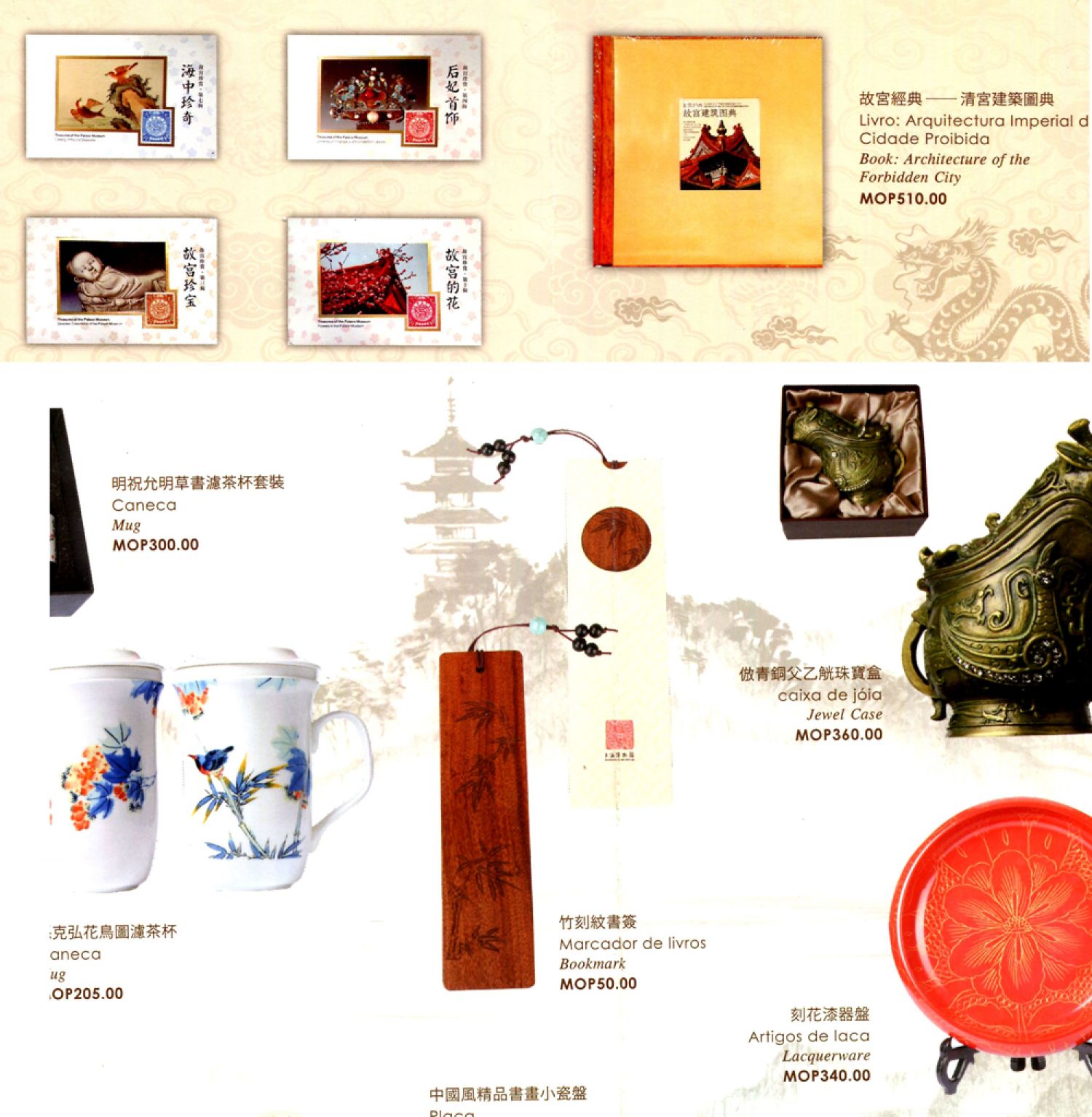
This monument, classified by UNESCO, holds an extraordinary historical and cultural significance, as a result of being the residency of the Chinese Emperors, located in the capital, the center of political power. Even though it is not uncommon for museum shops to sell goods from other museums (especially the ones that hold masterpieces), the fact that this offer is available at MAM, strikes me as a crucial fact and should not be overlooked in the context of this analysis.
It is also noteworthy that MAM also manages the Handover Gifts Museum of Macau, situated across the street. Opened to the public in 2004[13], its aim is «(...) to commemorate the handover for its significance in Macao’s modern history. The inauguration of the Museum on the 5th anniversary of the handover is also indeed significant and momentous.» Albeit the institution doesn’t claim itself as an art museum, its main exhibition displays the gifts offered by the 56 Chinese ethnies to Macau, produced by masters in each speciality of Chinese Art (jade work, wood carving, ceramics, etc.), «designed with the nation's unique artistic regional styles and representing best wishes of the ethnic groups towards Macao's prosperous future.»[14] The narrative crafted with these art pieces is a political one; it emphasizes the celebration of Macau’s return to the Motherland, demonstrating the recovery of China’s control over the territory, and it stresses the Greatness of the country, displaying masterpieces produced for that specific and important event. The relationship between art and ideology is, therefore, very much alive and accentuated not only in this museum, but also in the connection between these two institutions.
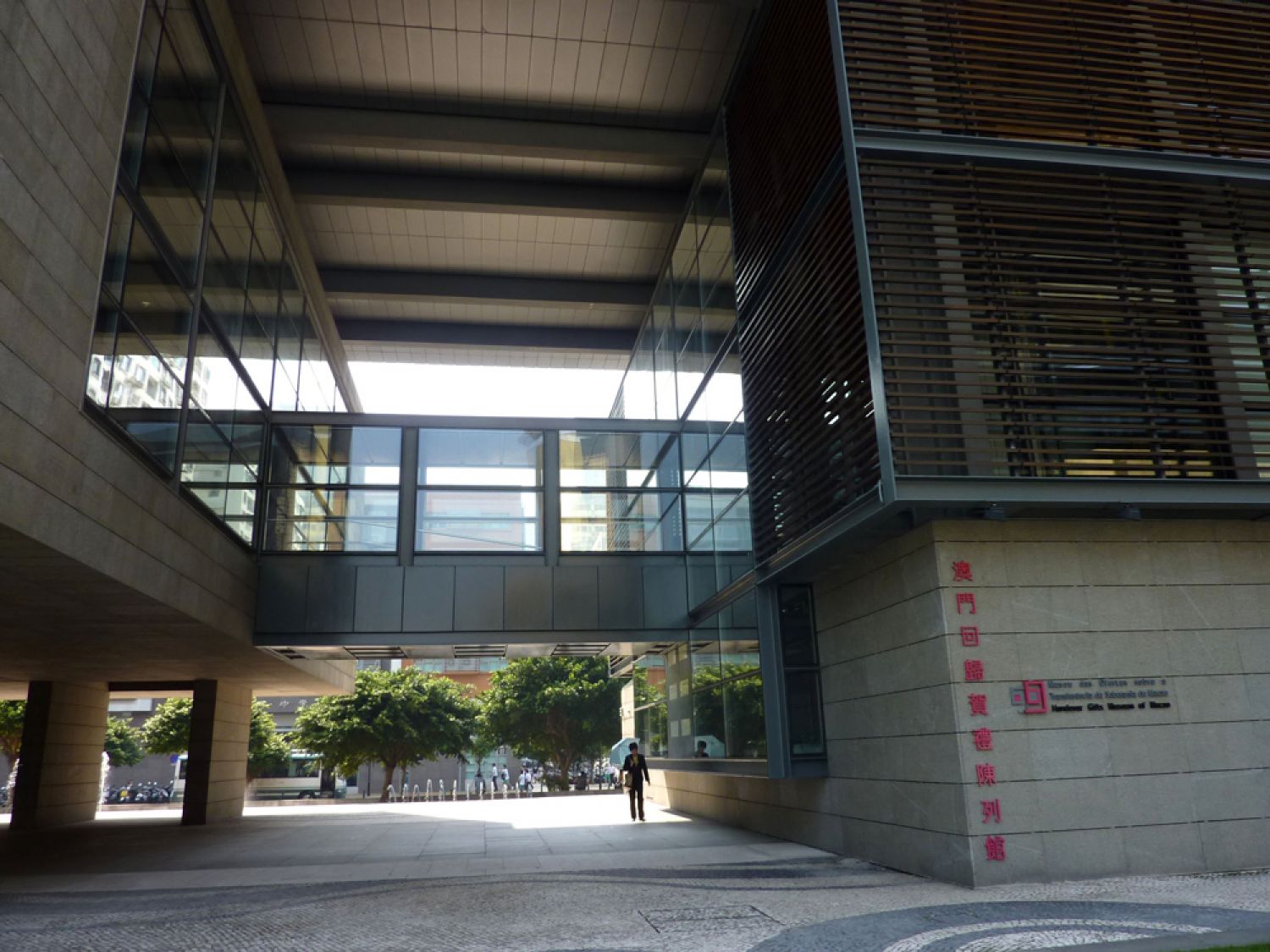
3. Mission
The museum’s mission is one of its most important declarations, by virtue of being «(…) an objective statement of the underlying rationale for its existence.» (Lord & Lord, 2001, p. 340). In this case and as affirmed on its website, MAM’s mission is «To pursue the objective 'Art, to create and to share' and the motto 'Life.Love.Art', and also to promote art education through multiple activities and programs[15]. It highlights the exhibitions «(…) featuring Ming and Qing dynasties calligraphy, painting and other cultural relics»[16], thus pointing out, very clearly, the importance of Chinese art for the accomplishment of the museum’s goals. Despite the artistic and cultural significance of the latter, as the following description of museum collections will show us, the exaggeration of its relevance in a Museum that aims to be representative of Arts in Macau cannot be disregarded, neither at a political level, formulating patriotic discourses, nor artistically wise, in the sense that the other collections seem to fade or/and appear less relevant to visitors.
4. Collections
MAM holds a variety of collections: Chinese traditional paintings, ceramics, calligraphy, seal carvings; contemporary art from Macau and photographic and documental materials – photographies from «Old Macao», propaganda posters, and so forth. Most of them belonged to «Luis de Camoens Museum» – the first museum of art in Macau,[17] – but acquisitions are made regularly as well.
The highlighted collections[18] are divided in three groups:
– A-Má Temple in Art: features paintings and drawings (some of them by renowned western artists, like Auguste Borget) of the most ancient temple in Macau, located in Barra. Allegedly[19] built in the 15th century, this religious structure is composed by several pavilions dedicated to the Taoist deity A-Má, protector of sailors and all maritime activities. Symbol of the religious and traditional life of Macau and set on a privileged location, by the waterfront (and thus, a testimony of the daily life of a maritime port), the A-Má Temple, its costumes and beliefs, was a favourite subject of many artists who travelled by Macau since the 18th century onwards.
– Shiwan Ceramics: This type of Chinese pottery has been produced in Shiwan (near Foshan, city located in the Guangdong Province) by many generations of craftsmen and it’s characterized by its thick material, colourful glazes and variety of forms. Usually the ware was manufactured for daily use and religious functions (such as temple roof ornamentation) but it soon developed more decorative aspects. This is the case of the ceramic figurines that portrayed opera or novel characters and historical figures and heroes. The kilns in Foshan (where an imperial furnace was also located) achieved major development and production during the Ming and Qing Dynasties[20]. Part of the museum’s Shiwan Ceramics - namely the large scale figurines – belonged to the private collection of Manuel Silva Mendes, a Portuguese attorney who lived in Macau in the 19th century and ordered them from the Masters, Pan Yu Shu and Chen Wei Yan[21].
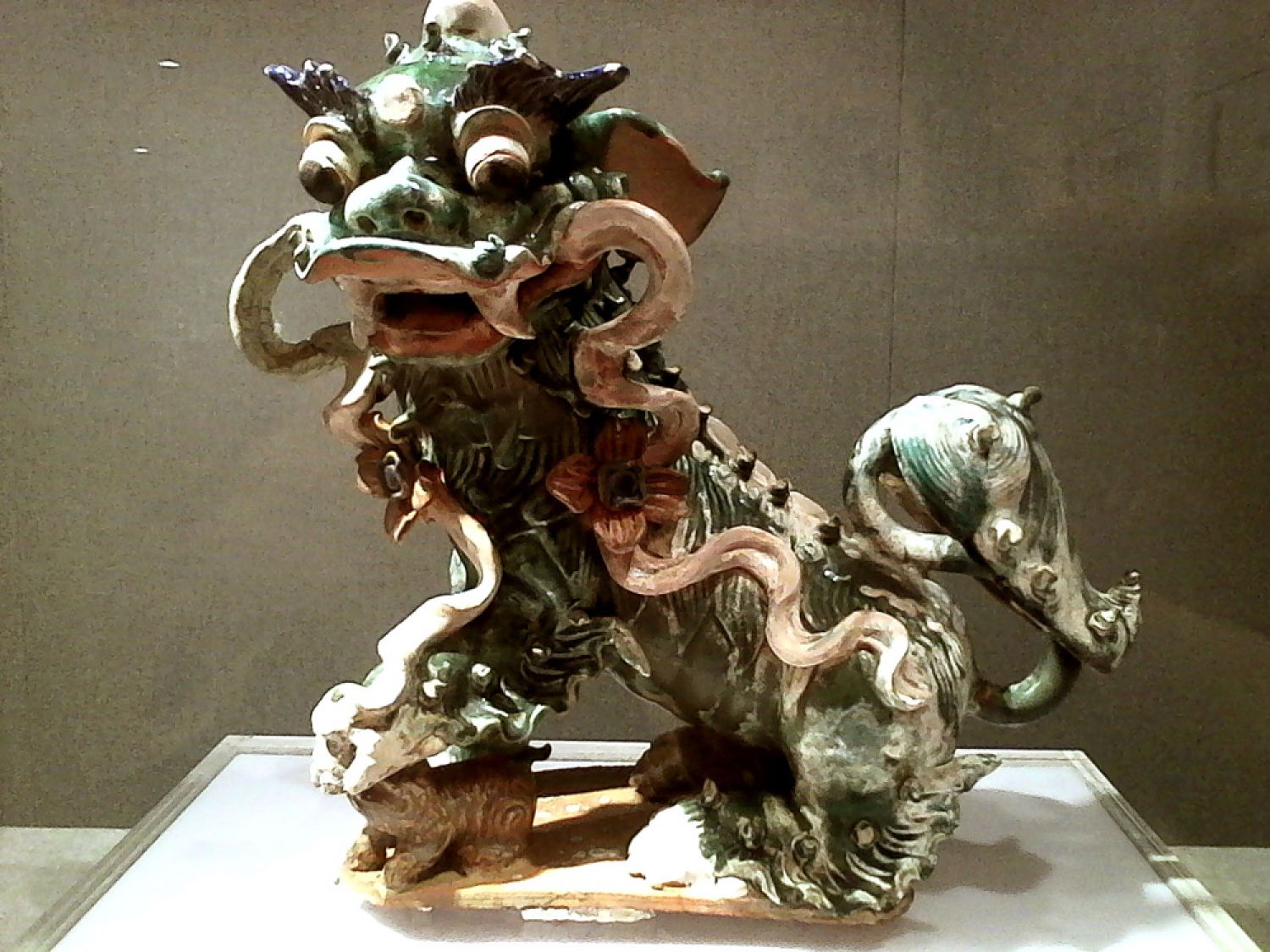
– Historical Paintings of Macao in the 19th century: a group of paintings, mainly from western and Macanese painters; some of the most renowned artworks belong to George Chinnery, Auguste Borget and Marciano Baptista. They depicted scenes of the city’s daily life, its population and commercial activities, but also western personalities that live or passed by Macau in that time period. Due to the geographic proximity of Guangdong and the relationship between the two ports, this collection also includes landscapes and maritime activities of those two coastal areas.
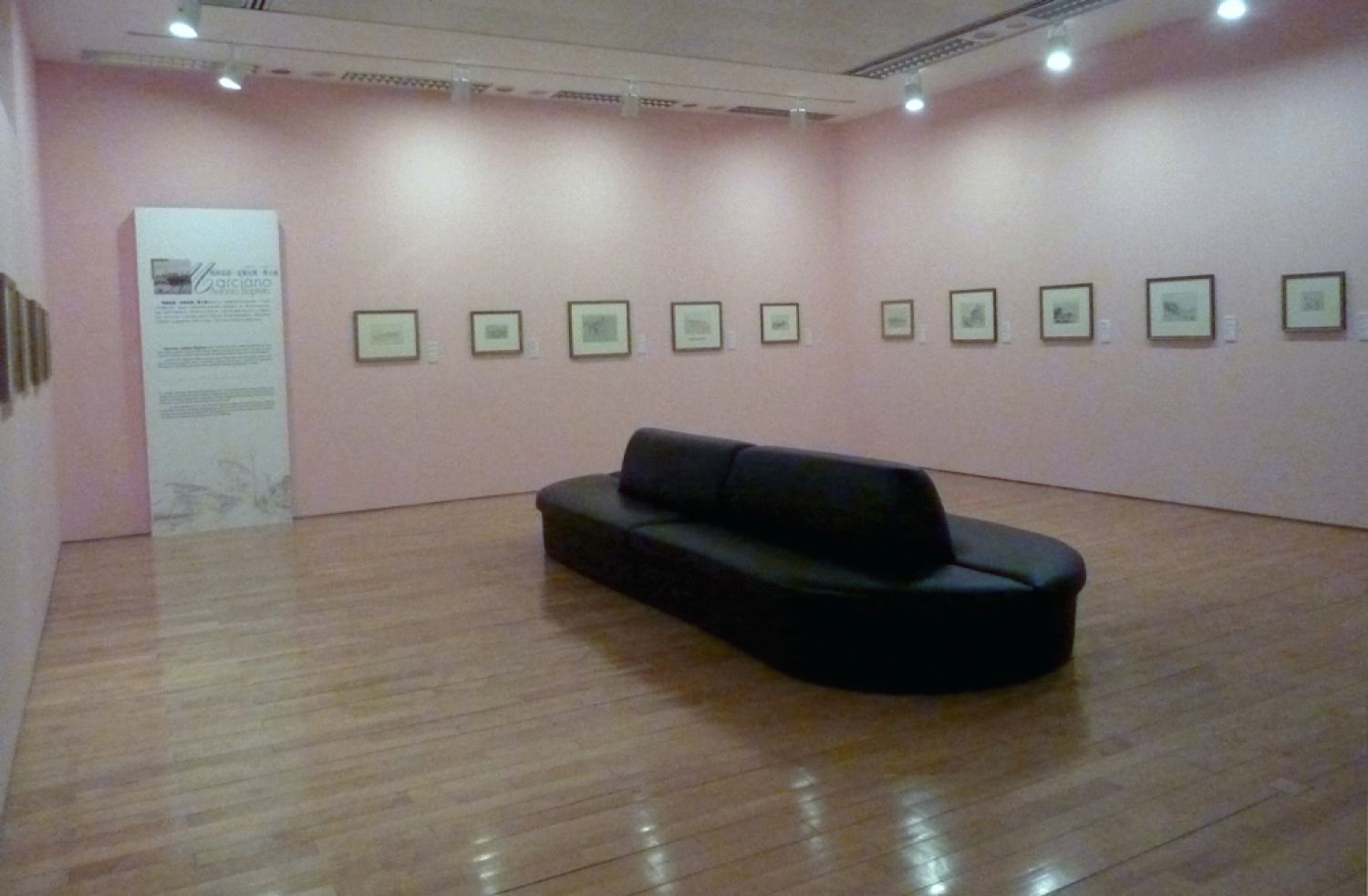
Accordingly, the analysis of the museum’s featured collection provides us significant information about the political appropriation of the institution for ideological purposes by the local and central governments, in the sense that the selection of artworks by the curators wasn’t merely based on artistic and historical criteria, but also on the symbolic significance for China and its History.
The A-Má Temple artworks are one of the examples that illustrate the above affirmation. The theory that the first pavilion of the Temple is dated from 1488 – which has been backed up by several studies from the Chinese Academy –, was questioned by some recent research[22], a situation that arose a heated and intense debate between Chinese and Western scholars. Setting an early construction date for the temple proves that it precedes the Portuguese arrival to the territory. This means that if there was a religious structure, some kind of village subsisted by then and consequently the city wasn’t developed because of the Portuguese settlement. This narrative constructed around the temple and its origins turns the monument into a powerful anti-colonial symbol, due to its importance for Macau and its communities, and disseminates a clear message of China’s power and control over the territory’s history and its formation.
Conversely, we can find the same message in the section of «Shiwan Ceramics». The production reached its peak during the Ming Dynasty[23] and the prosperity of the kilns, as well as the notoriety of its pieces, is intimately connected with the millenary History of China and subsequently a symbol of its cultural and national identity.
5. Exhibitions
MAM currently displays three permanent exhibitions: the «Shiwan Ceramics», the «Historical Paintings of Macao in the 19th century» (both scrutinized formerly in the collection section) and «Calligraphy and Paintings from Canton Masters». This segment exhibits a selection of scrolls by masters from the Guangdong area.
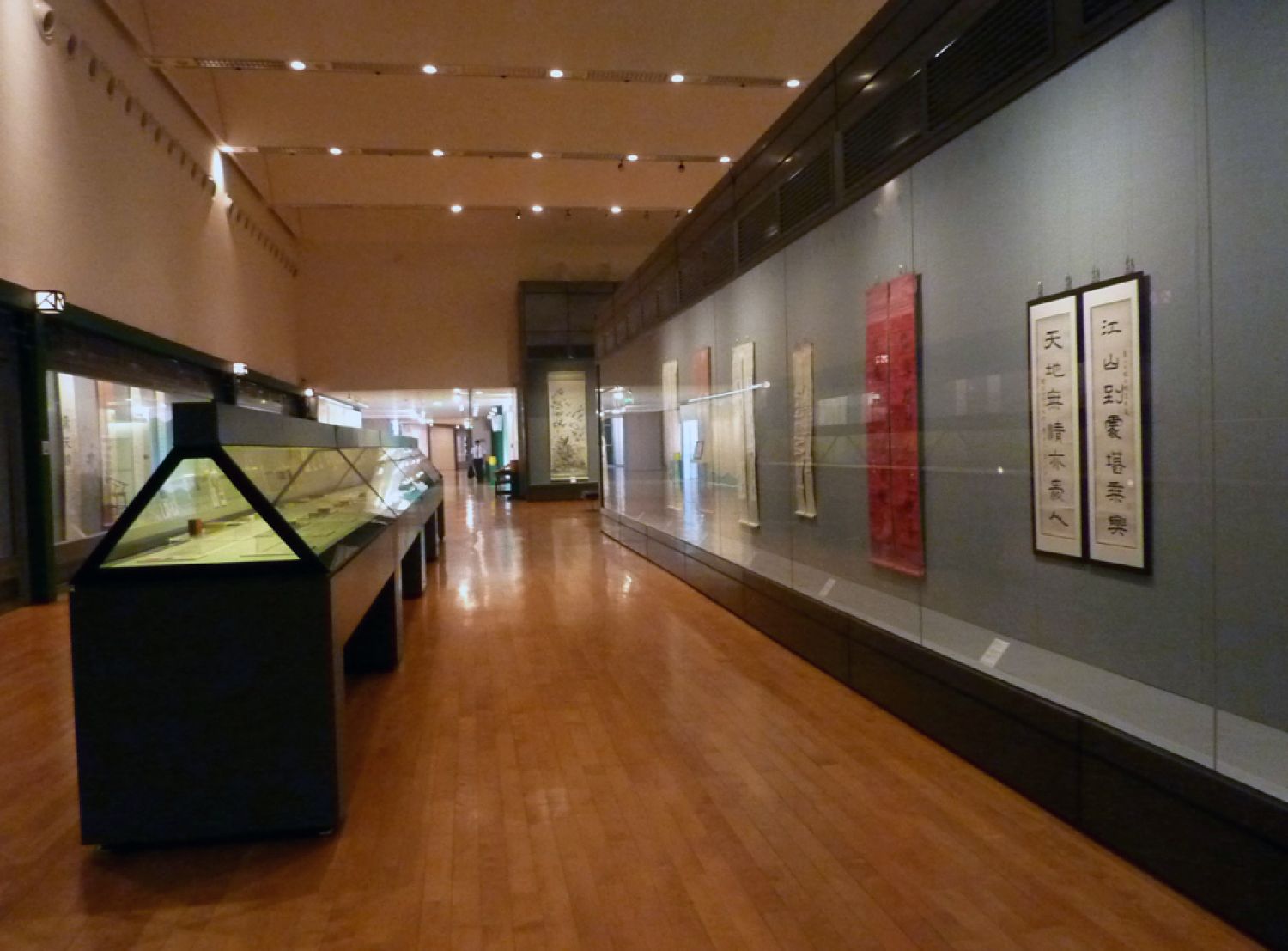
The museum also presents temporary exhibitions, displaying contemporary art (painting, serigraphy, etc.) from local artists (mainly Chinese from Macau, some Portuguese and Macanese). Others are organized in cooperation with western museums of art, such as Plato in the Land of Confucius: Greek Art (2008); Auguste Borget: A Painter-Traveller on the South China Coast (2016), to name a few, but predominantly displays exhibitions from Chinese museums of art, particularly the Imperial Palace: Beauty & Entirety: Ceramics of the Song Dynasty from the Palace Museum (2011); Noble Virtuosity: Imperial Jades of the Qing Dynasty from the Palace Museum (2012); Art As Legend – Artworks of Qi Baishi from the Collection of the Beijing Fine Art Academy (2014)[24], and others.
Examining the history of MAM’s exhibitions, whether temporary or permanent, has proven very valuable for this paper’s purpose. The themes and museographic options have varied greatly since the museum’s inauguration. That discrepancy is not, of course, an act of randomness, but rather a conscious choice of the curators, driven by political factors. Because it opened to the public prior to the Handover Ceremony, one of the floors displayed an exhibit dedicated to the Portuguese presence in the territory. Nonetheless, this is not considered in the MAM’s exhibition timeline and it is only mentioned in the book dedicated to Macau’s Museums, dated from 1999 (Faria & Grilo), where MAM is also surveyed. This piece of Museum’s history has been removed as a way of eclipsing the colonial period of Macau.
Moreover, the first temporary exhibition featured by the museum is one related with the Imperial Palace collections: Exhibition of the best imperial palace objects, calligraphy and painting works (1999). Symbolically and yet again, marking the beggining of an Epoch whilst erasing an «inconvenient» fact. Following the previous examination of the collections and exhibits, one cannot leave unnoticed the consistent and homogeneous narrative that is being built through the conjugation of these elements, thus detecting the contraction of the cultural and symbolic distance between Macau and China, demonstrating its closer and attentive presence over the territory, particularly in the cultural sector.
2.3. Political appropriations of MAM
In the course of the analysis of the previous aspects of the museum, it is possible to reach some exploratory outcomes, that I will describe and explain in the next sections.
I. There seems to be a political appropriation of the institution for nationalist purposes[25]. The highlighted collections and displays, the mission, the chosen geographical location, the relationship with HGM, and the presence of the Imperial Palace shop, reinforce, on the one hand, China’s omnipresence in and over this autonomous territory, demonstrating control and power that is not solely political but also symbolic. Additionally, the combination of these elements creates a narrative of cultural hegemony and therefore a sense of belonging to the national and cultural Chinese identity[26]: «The display of art in museums operates as power-plays in the sense that seeing art objects and encountering interpretations of history can alter people’s attitudes to certain political values.» (Luke, 2002, p. 2) Although MAM is located in a multicultural society and that attribute was one of the causes of its prosperity since the early period of its formation, this is not valued in that specific space, as the museum contents and options don’t reflect that contamination of fluxes. Chinese art has always been at the centre of the Museum’s practices and discourses, as it was exposed previously, expressing a political ideology through curatorial choices. «In this respect museums are the sites within which ideology is displayed as much as they are sites where collections of artefacts are displayed.» (Gray, 2014, p. 17). Then again, this situation presents important outcomes concerning the museum’s educative role, since it disseminates a totalizing conception of Art and, consequently, History, simultaneously generating a discrepancy of visions of Macau and its culture.
The influence of PRC’s state ideology is not limited to the political appropriation of MAM’s institutional practices and discourses but it also occurs in a broader extent in the cultural sector. Particularly, it concerns how the hybrid cultural and artistic heritage of Macau, and the measures for its preservation, are approached and handled in The Five-Year Development Plan (2016-2020) of the Macao Special Administrative Region (Macao SAR)[27]. In fact, even though specific legislation for the protection of cultural heritage was recently promulgated (2013), this matter is not considered individually in that Plan, but appears integrated in the section «improving population well-being», through the education and promotion of the values «love for the country and for Macao» (2016, p. 47). This conveys a clear and not so subtle patriotic message of «loving the Motherland» and establishing a strong and «unbreakable» bond between the two territories, whilst trying slowly to implement patriotic education.
In the same chapter and supporting this patriotic and nationalist narrative, it is strongly affirmed that «Macao’s culture has inherited the Lingnan[28] culture, which is a part of Chinese Culture, the mainstream of Macao culture», (Ibid, p. 48) hence replacing and overshadowing the relevance of the hybrid cultural assets that support the post-colonial cultural identity of Macau. Those referents, a result of four centuries of intercultural connections between the East and the West, were selected by the local government after the Handover Ceremony and are an important part of the uniqueness of the territory, and were responsible for the classification of the «Historical Center» as World Heritage by UNESCO, in 2005[29].
II. The anomalous colonial situation of Macau, which didn’t ensue a process of decolonization but the return to a larger country, generates a dissonance between the MAM’s role as a post-colonial institution and the roles of cultural institutions that were built in post-colonial contexts and their connections with the (re)configuration of cultural identities.
In the latter, they were founded to commemorate independence and liberation from the violence and subjugation of colonial forces. An act of resistance and reflection on the struggles of the local communities towards the aggression and hostility of colonial empires. They are also outlined as spaces for inclusion and cultural representation – which was lacking from the colonial museography –, where artworks that critically address those difficult, complex and traumatic issues, should be displayed (De Angelis et al, 2014)
This is not what happened in Macau nor in this case study, partly for the reason of its singular and political and colonial status, which has to be always taken in consideration when examining this institution. First, the museum was not founded to celebrate the liberation from colonial oppression, since the territory was integrated in PRC, but to showcase the Arts in/of Macau. However, the city experienced a colonial period in the 19th century that led to a clash between the Portuguese and the Chinese, which means that political, diplomatic and even everyday relationships between the two communities became stiffer and more difficult. Nevertheless, the conflict is absent from the museum’s space and discourse in any shape of form. The collections and displays, even the ones that could have brought up the discussion, such as the «Historical Paintings of Macau in the 19th Century»[30], are «silent». Hence, the remains of the colonial past are invisible or hidden under artworks that present «neutral» themes and make use of conciliatory terms, such as «harmony» and «cultural coexistence». Discussion, disruption, agitation, interrogation, are missing verbs and actions in the museum’s environment; anything that disturbs and unsettles the «aura» of the institution and its collections is imperceptible, untraceable, unnoticeable. Confrontation is replaced by contemplation and aesthetic gaze of artefacts, generating a sterile environment for critical thought whilst disseminating nationalist messages: «(…) the nature of the vision of national identity that museum exhibitions encapsulate, implicitly or explicitly, through the way in which they interpret national and local history, by what they choose to emphasize and what they choose to omit.» (Vickers, 2007, p. 366)

Second and following the previous dissertation, the displayed artworks are not a form of resistance to the «oppressor», in the sense that the Portuguese held an authorization, from the Chinese authorities, for settling and administering the territory. Besides, the hybridity that in the past permeated the artistic creation in every domain (architecture, painting, etc.) and that is a part of the city’s cultural and historical legacy, is not as discernible and evident as before, by virtue of a much needed sensibility in approaching certain themes and subjects, especially if they carry a political dimension.
Third, there’s an underrepresentation of Macau’s multicultural communities. The institutional and artistic museum practices don’t reflect cultural diversity and plurality of perspectives. For instance, the Filipino community, the second largest one following the Chinese, is not represented in the museum’s space. Even some of the educational activities, such as workshops and conferences, are spoken in Cantonese, targeting the local Chinese communities and excluding all the others. Hence MAM isn’t a place of (displaced) memories (due to the movements of groups with different ethnic and geographical backgrounds) but a place for one memory, carefully selected, structured and transmitted through the display of artefacts, valuing and privileging Chinese traditional arts. Choosing to represent and stand for certain groups is a conscious option of the museum that explicitly aims to shape particular national and cultural identities (Duncan, 1991, p. 102). This situation affects how the museum communicates with its audience and especially how it engages with local communities, which is critical in the processes of (re)configuration of cultural identities. Their perception of invisibleness in the museum’s space and the insufficient effort of MAM’s in promoting participatory activities and creating emotional links with the local community is responsible for the institution’s lack of relevance for them: «(…) Museums can be powerful identity-defining machines. To control a museum, means precisely to control the representation of a community and some of its highest, authoritative truths. It also means the power to define and rank people to declare some as having a greater share than others in the community’s common heritage – in its very identity.» (Ibid, id) These are exactly the opposite practices and behaviours that museums should encourage and embody in the 21st century.
III. Hence, Museums aren’t neutral grounds but political arenas for exercising ideological power and control (Gray, 2014, p. 81). In this case, narratives and meanings, concerning the Nation and the Chinese national and cultural identity, are constructed and reconstructed through the highlighted collections, displays and the other examined elements. The museum acts as an operative and transformative agent in the construction of knowledge and in the way the Chinese nation is perceived through art. It shapes national and cultural identities, as it is an institution holding cultural authority and legitimacy: «The state authorities exercise considerable power reinforcing political ideologies through the communication of messages about preferred versions of identities.» (Stokes-Rees, 2007, 28)
In this sense, MAM embodies similar practices, discourses and features from the national museums in European modernity: an ideological and political apparatus that conveys its power and influence, not only locally (throughout the mentioned mechanisms) but also internationally, cooperating with Western museums of art. The museum it still is a «ritual of citizenship» (Duncan, 1991), instructing and enlightening the visitors about the «Greatness» of the country, accentuating its success and development and, at the same time, establishing bonds between the institution and the Motherland. It is a vehicle for patriotic education, and this regressive vision of these kind of cultural organizations is incompatible with contemporary society, especially concerning their educative role. MAM stands as the link between Macau and the latter instead of connecting the territory with its communities. The «Museum Forum», as stated by Cameron (1971), doesn’t fit in this formula; it is still a Temple, where dialogue between artworks and visitors is unattainable. Furthermore, these Modern values are expressed in the museum «fever» that China has been experiencing, building multiple institutions as symbols of modernity and westernization – particularly contemporary art museums –, architectural icons and detaining a prominent position in the global arts market (Yung-Wen, 2015)[31]. They are the manifestation of China’s «new image», a country that attempts to establish closer and intimate bonds with the Western world. In this process, museums fulfil a critical and vital role as agents of cultural diplomacy (Gray, 2014; Yung-Wen, 2015).
From the examination of MAM’s practices and elements it is possible to infer that, although the interferences of Central Government (or Local Government in cooperation with the latter) in the cultural sector of Macau are subtle, a closer analysis allows us to detect nationalist and patriotic modes of thinking, which are reflected in the ways of doing. This situation reveals, however, a delicate balance between the maintenance of the cultural identity of the territory, whose references are its cultural and artistic heritage, a hybrid historical legacy; and the strengthening of the power and political control of the central government on Macau’s cultural and artistic assets, as well as on the organizations that are committed with its protection.
Even if museums, as European institutions, subsist in non-western countries, it’s not possible to implement new institutional practices that characterize the above: «(…) the development of a fundamentally reflective practice [should] be embedded within and across the museum.» (Lynch, 2014, p. 87) And as revealed by this case study, this is not yet an achievable reality. Nevertheless, these sensitive issues must be addressed internationally and demand more reflection and thinking so that the museum can still be relevant to its visitors, in the 21st century.
Bibliography
BENNET, Tony. (1995). The Birth of the Museum. London & New York: Routledge.
CAMERON, Duncan F., «The museum a Temple or the Forum». Curator, the
Museum Journal, Volume 14, Issue 1, March 1971, pp. 11-24.
CHENG, Christina Miu Bing. (1999). Macau: a Cultural Janus. Hong Kong: Hong Kong University Press.
CLAYTON, Cathryn Hope, «City of museums. Reflections on Exhibiting Macao». Review of Culture – Edição Internacional, n.º 5, 2003. Macau: Instituto Cultural, pp. 99-124.
DE ANGELIS, Alessandra; IANNICIELLO, Celeste; Mariangela ORABONA; QUADRARO, Michaela «Introduction: Disruptive encounters – Museums, Art and Postcoloniality» in CHAMBERS, Iain; DE ANGELIS, Alessandra; IANNICIELLO, Celeste; Mariangela ORABONA; QUADRARO, Michaela (eds.). (2014). The Postcolonial Museum: The Arts of Memory and the Pressures of History. Surrey & Burlington: Ashgate, pp. 1-22.
DUNCAN, Carol, «Art museums and the ritual of citizenship» in KARP, Ivan; LAVINE, Steven D. (1991). Exhibiting Cultures. The Poetics and Politics of Museum Display. Washington: Smithsonian Books, pp. 88-103.
FARIA, Daniela Carvalho; GRILO, Eduardo (Fot.). (1999). Museus de Macau. Macau: Primeira Impressão, Lda.
FERNANDES, Moisés Silva, «Portuguese Behavior towards the political transition and regional integration of Macau in the Pearl River Region» in RAMOS, Rufino; DINIS, José Rocha; WILSON, Rex; YUAN, D.Y. Yuan (eds.). (1996). Macau and its Neighbours in Transition. Proceedings of the international conference held at the University of Macau, March 18-19, 1996, Macau: Faculty of Social Sciences and Humanities, University of Macau, Macau Foundation, pp. 45-56
_______, «A normalização das relações luso-chinesas e a questão da retrocessão de Macau à China, 1974-1999» in Revista Administração, n.º 61, Vol. XVI, 3.º, 2003, pp. 1077-1141.
GOVERNO da RAEM. (2009). Projecto de Lei de Salvaguarda do Património Cultural. [Online] Macau: Instituto Cultural do Governo da R.A.E. de Macau. Available at http://bo.io.gov.mo/bo/i/2013/36/lei11.asp. Accessed: February 15, 2017.
GOVERNMENT OF MACAO SPECIAL ADMINISTRATIVE REGION. (2016). The Five-Year Development Plan (2016-2020) of the Macao Special Administrative Region (Macao SAR). [Online] Available at http://www.cccmtl.gov.mo/files/plano_quinquenal_en.pdf. Accessed: February 15, 2017.
GRAY, Clive. (2014). The Politics of Museums. New York: Pallgrave McMillan.
HOOPER-GREENHILL, Eilean. (1992). Museums and the Shaping of Knowledge. London & New York: Routledge.
HOOPER-GREENHILL, E. (ed.). (1995). Museum, Media, Message. London & New York: Routledge.
HOOPER-GREENHILL, Eilean. (2000). Museums and the Interpretation of Visual Culture. London & New York: Routledge.
HOOPER-GREENHILL, Eilean, «Education, communication and interpretation; towards a critical pedagogy in museums» in HOOPER-GREENHILL, Eilean (ed.). [1992] (2004). The Educational Role of the Museum. London & New York: Routledge, pp. 3-27.
HOOPER-GREENHILL, Eilean, «Communication in theory and practice» in HOOPER-GREENHILL, Eilean (ed.), [1992] (2004), The Educational Role of the Museum. London & New York: Routledge, pp. 28-43.
LYNCH, «Generally Dissatisfied: Hidden Pedagogy in the Postcolonial Museum» [Online] in THEMA. La revue des Musées de la civilisation, 2014, pp. 93-106 Available at https://thema.mcq.org/index.php/Thema/article/download/27/pdf. Accessed: February 15, 2017.
LORD, Barry; LORD, Gail Dexter (eds.). (2001). The Manual of Museum Exhibitions. Walnut Creek: Altamira Press.
LUKE, Timothy W. (2002). Museum Politics. Power Plays at the Exhibition. Minnesota: University of Minnesota Press.
McLEAN, Fiona. (2003). Marketing the Museum. London & New York: Routledge.
NUNES, Isabel, «O Museu Luís de Camões e a sua criação». Revista de Cultura- Edição Portuguesa, n.º16, Outubro-Dezembro 1991. Macau: Instituto Cultural de Macau, pp. 187-195.
PING, Jin Guo; ZHILIANG, Wu. (2003). «Tentativa de uma nova abordagem às origens históricas da presença portuguesa em Macau». Revista de Cultura – Edição Internacional, n.º 8, Outubro de 2003, pp. 71-111.
_______, (2007). Revisitar os Primórdios de Macau: para uma Nova Abordagem da História. Macau: Instituto Português do Oriente, Fundação Oriente.
SANTOS, Boaventura de Sousa, «Entre Próspero e Caliban: colonialismo, pós-colonialismo e interidentidade.» in RAMALHO, Maria Irene; RIBEIRO, António Sousa (2002). Entre Ser e Estar: Raízes, Percursos e Discursos da Identidade. Porto: Afrontamento, pp. 23-85.
SHIBAO, Tan, «Estudos sobre a Lenda das Aldeias na Península de Macau antes da sua fundação» in Revista de Cultura – Edição Internacional, n.º 1, Janeiro 2002, pp. 20-32. Macau: Instituto Cultural do Governo da R.A.E. de Macau.
_______, «Descobertas Arqueológicas no Templo de A-Má.» Revista de Cultura – Edição Portuguesa, n.º 29, II Série, Outubro-Dezembro 1996, pp. 207-242. Macau: Instituto Cultural de Macau.
STOKES-REES, Emily, «‘We need something of our own’: Representing Ethnicity, Diversity, and ‘National Heritage’ in Singapore.» [Online] in AMUNDSEN, Arne Bugge; NYBLOM, Andreas (eds.). National Museums in a Global World. Conference Proceedings. University of Oslo, Norway, November 19–21, 2007. Linköping: Linköping University Electronic Press, pp. 21-37. Available at http://www.ep.liu.se/ecp/031/002/ecp0703102.pdf. Accessed: February 15, 2017.
TEIXEIRA, Manuel. (1990). Ma-Kok-Miu. Templo Chinês da Barra. Macau: Gabinete de Comunicação Social.
TSE, Thomas Kwan Choi, «Remaking Chinese identity: hegemonic struggles over national education in Post-Colonial Hong Kong» [Online]. International Studies in Sociology of Education, Vol. 17, n.º 3, September 2007, pp. 231-248. Available at http://www.tandfonline.com/doi/abs/10.1080/09620210701543908. Accessed: March 5, 2017.
VICKERS, Edward, «Museums and nationalism in contemporary China». Compare: A Journal of Comparative Education, Vol. 37, n.º 3, June 2007, pp. 365-382.
YUNG-WEN, Yao, «The void of Chineseness: contemporary art and cultural diplomacy in China». International Journal of Social Science and Humanity, Vol. 5, n.º 11, November 2015, pp. 971-975.
XIAOWANG, Xu, «Os Fuquineses e a origem do culto de A-Má em Macau». Revista de Cultura – Edição Portuguesa, II Série, n.º 37, Outubro-Dezembro 1998, pp. 89-102. Macau: Instituto Cultural de Macau.
Footnotes
- ^ «In a rapidly commercialising and modernising China, the promotion of a state centered patriotism has become a key instrument for the regime in its efforts to preserve its legitimacy, and museums represent a key element in this strategy.» (Vickers, 2007, p. 365)
- ^ My PhD dissertation’s project is focused on the cultural and artistic heritage of Macau and its role and connections in the process of configuration and reconfiguration of the local communities’ cultural identities and the digital media applied to museums in post-colonial contexts.
- ^ The data collected for this paper was gathered through fieldwork (several visits to the museum) and bibliographic and documental research.
- ^ The main conflicts were triggered by the presence of General Ferreira do Amaral, sent to Macau to impose «order». He decided to implement unpopular measures that affected the Chinese community in its core: commanding the destruction of Chinese cemeteries to build roads.
- ^ The main conflict in the 20th century was the «123 incident», a riot between pro-communist Chinese groups and Portuguese and Macanese authorities.
- ^ The Joint Declaration of the Government of the Portuguese Republic and Government of the People's Republic of China on the Macao Question was signed in 1987 by the Presidents of both Portugal and China.
- ^ 1987-1999.
- ^ The legislation for the protection and safeguarding of Macau’s Cultural and Artistic Heritage was crucial, considering that many cultural assets of great historical and artistic significance were destroyed in the 19th and part of the 20th centuries.
- ^ Novos Aterros do Porto Exterior, an area obtained by landfilling.
- ^ The lack of space for construction was and still is a recurrent problem in Macau. During the 1980s and 1990s new building areas were created by land reclamation.
- ^ Cultural Affairs Bureau of Macau.
- ^ http://www.mam.gov.mo/e/about
- ^ «The location of the Museum is also the area that was used for the handover ceremony on December 20, 1999 in which Macao was returned to the Mainland. When the hall was dismantled after the ceremony the area became part of the Macao Cultural Centre. Construction work for the Handover Gifts Museum of Macao started in March 2003 and was completed in October 2004». http://www.icm.gov.mo/handovermuseum/mainFrame.asp?contentPage=0&Language=3
- ^ http://en.macaotourism.gov.mo/sightseeing/sightseeing_detail.php?c=2&id=13#.WPOHoYjyvIU
- ^ «MAM organises various exhibitions and art-minded activities, while enhancing collaboration with local artists and arts groups to build cultural and creative platforms, in a bid to promote the development of art in Macao and to become a service-oriented museum.» http://www.mam.gov.mo/e/about
- ^ http://www.mam.gov.mo/e/about
- ^ The museum officially opened in 1960, in the building that nowadays houses the Macau delegation of Fundação Oriente, but by virtue of having had an erratic existence, it closed down soon after (Nunes, 1991).
- ^ This important information is provided solely by the museum’s website, the most (and only) communicative support of this institution. Besides the visit to the museum and the short leaflet available to visitors at the reception, it is very hard to conduct a rigorous analysis of the institution through its communicative written material due to the fact that it is inexistent.
- ^ This is the official date of construction of the Temple, propagated by the touristic services and the cultural organizations.
- ^ Ming Dynasty: 1368-1644; Qing Dynasty: 1644-1912 (http://afe.easia.columbia.edu/timelines/china_timeline.htm)
- ^ http://www.mam.gov.mo/e/collection/1/detail/6c0bf2b5-8145-4d35-bce3-da175a40b48a
- ^ Ping & Zhiliang, 2003; Shibao, 1996; 2002.
- ^ The last imperial dynasty ruled by Han ethnic Chinese, before the rise of the Manchu that led to the establishment of the Qing Dynasty (http://afe.easia.columbia.edu/timelines/china_timeline.htm)
- ^ http://www.mam.gov.mo/e/resource/1
- ^ «(…) nationalism fulfils a very real emotional need – for a sense of belonging, a sense that one is a member of a larger community that commands respect and bestows dignity.» (Vickers, 2007, p. 368)
- ^ Even though all these instruments are aimed by PRC to propagate a unified vision of the National and Culture Identity, the process of belonging turns out to be contradictory, in the sense that these two latter concepts are not inclusive of all China’s ethnicities. In fact, they consider solely the Han, excluding other ethnic minorities and therefore defeating the purpose of establishing a National identity (Vickers, 2007, p. 377). This is a complex situation that needs to be looked over by examining in depth China’s History.
- ^ http://www.cccmtl.gov.mo/files/plano_quinquenal_en.pdf. This plan, that was presented to the public last year, in Macau, «aims at laying down a blueprint for how the city can achieve its strategic aims of being a world centre of tourism and leisure, and a commercial and trade cooperation service platform between China and the Portuguese-speaking countries (collectively known as the «Centre and Platform» policies)». http://www.gcs.gov.mo/showNews.php?DataUcn=99091&PageLang=E «(…) In order to speed improvements to Macao’s living and working conditions; and for enhancement of the city’s transport, travel and entertainment facilities. The document also contains comprehensive policies designed to fulfil the city’s short-, mid-, and long-term needs.» http://www.gcs.gov.mo/showNews.php?DataUcn=103615&PageLang=E
- ^ Lingnan is a geographical area in the South of China that comprises, amongst other regions, the province of Guangdong. Although some of the Chinese cultural heritage in Macau reveals influences of that region, due to immigration, it cannot be affirmed as the predominant style in Macau. As a multicultural city and commercial port, its culture is characterized exactly by a blend and hybridity of forms, shapes and styles.
- ^ In fact, it is also noteworthy that the main concern of this plan is transforming Macau into a «City of Culture»; cultural and artistic assets are means to achieve those goals and not a purpose in itself, which, again, is contradictory with the post-colonial cultural identity of Macau.
- ^ This collection would be, in my opinion, a good starting point for the debate since it concerns the 19th century, a global period of disruption: independence movements of European overseas territories; the beginning of the «colonial period» of Macau and a particularly difficult historical moment for China, due to the invasions from Western countries and Unequal Treaties, amongst other reasons.
- ^ «Chinese officials pointed out that the great cities of the world – New York, Paris, London – all have important museums and China should have too.» (Yung-Wen, 2015, p. 973)


